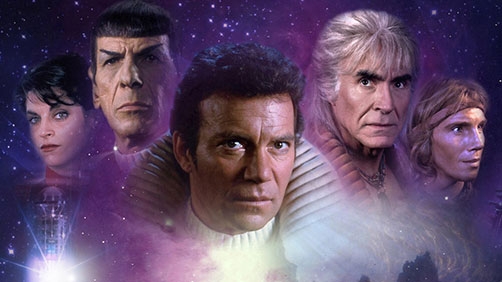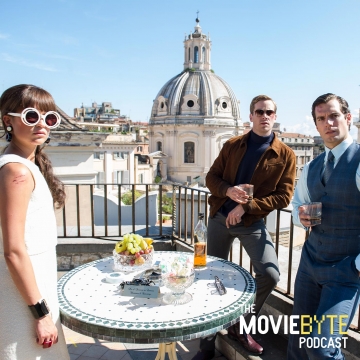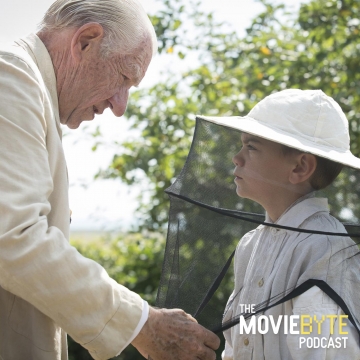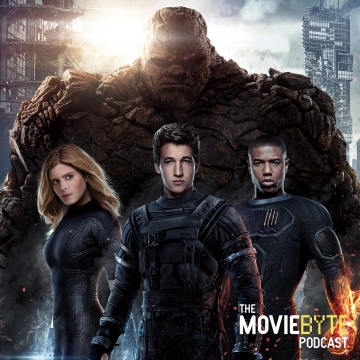
“THIS IS CETI ALPHA FIVE!”
No, actually, this is not Ceti Alpha Five. But it is one of those reviews that I am really nervous to write. Why? you might ask. The answer is that this would be my second favorite film of all time. You might remember when I wrote my review of The Matrix that it was my favorite film of all time. Well this is the second film on that list.
It is true that I love pretty much all things that have to do with Star Trek, but I am not blind, nor do I place this film in second place of my favorite films list lightly. And indeed, as much as I love Star Trek, I think if I were to sit down and make a list of my top ten favorite films of all time, this would likely be the only Trek film on the list.
Warping out of Spacedock
Let me paint this picture for you properly. You see one thing that we often don’t think of is that in 1982 when The Wrath of Khan came out, there was not much Trek to build on. There had been 79 episodes in The Original Series, and one feature film that was quite frankly not much good.
While I do enjoy a few episodes of The Original Series it’s just not the most awesome TV show there has ever been. At times in fact, that show could get downright silly — cheesy to the point of painfulness. But one did not need a Vulcan mind meld to see that there was a lot of potential in that show, in fact there was just a lot of good to be had in the show, period. It was mixed in and around the cheese to be sure, but it was there. As saddled as that original Trek series was with late 60s culture, tropes, and cliché, it was still in many ways doggone good material. But the show was canceled because the ratings just weren’t where they needed to be.
So the fans pushed and pushed, Roddenberry pushed, rumors of more Trek abounded, and finally, in 1979, new Star Trek came about on the silver screen — lifeless, dull, dreary Star Trek. That first film is a classic example of what can go wrong when you think more highly of your material than you ought to think, when you don’t know your place, when you let your script get weighed down by heady ideals and concepts. That first film simply failed to warp out of spacedock and it left the franchise in a bad place indeed.
The Last of the Dilithium
And yet, for whatever reason, another Trek film was green-lit by the studio executives. But this time, the budget ballooning as seen on the previous film was not to be allowed. This time the fist was closed and the budget was $11 Million, no exceptions, no compromises. Additionally, Gene Roddenberry was given a “promotion” to executive consultant — this essentially meant that he would have no control over the production at all. As we will see, this turns out to be a very good thing. You see, in my opinion his concept of Star Trek was great, but his execution was terribly lackluster. His overly idealistic approach would often make his characters hard to relate to and provide little drama.
So for this “last hurrah” of Star Trek, Harve Bennett was brought in to produce, and he hired Nicholas Meyer to direct. Nicholas Meyer didn’t know much about Star Trek which in retrospect was actually probably an asset. He was surrounded with enough people who knew enough about Trek to keep him from stepping on the land mines, but he also brought a sense of irreverence that was needed and completely lacking on the first Star Trek film.

Thrusters on Full
One of the best things that was recovered in this film, which was completely absent in the first film, was the character relationships and banter. The old energy and synergy from the series was back at warp speed in this one. Kirk, Spock, and McCoy even get an old style banter session/meeting in Kirk’s cabin:
McCoy: Dear Lord. You think we’re intelligent enough to… suppose… what if this thing were used where life already exists?
Spock: It would destroy such life in favor of its new matrix.
McCoy: Its “new matrix”? Do you have any idea what you’re saying?
Spock: I was not attempting to evaluate its moral implications, Doctor. As a matter of cosmic history, it has always been easier to destroy than to create.
McCoy: Not anymore; now we can do both at the same time! According to myth, the Earth was created in six days. Now, watch out! Here comes Genesis! We’ll do it for you in six minutes!
Spock: Really, Dr. McCoy. You must learn to govern your passions; they will be your undoing. Logic suggests…
McCoy: Logic? My God, the man’s talking about logic; we’re talking about universal Armageddon! You green-blooded, inhuman…
Classic.
And in fact, for the most part, the dialog in this film is exceptional, with only a couple of notable irritations and cheesiness.
Above all, this film is about the characters, the people, our friends in the Star Trek universe. The previous film had this element completely out of place with the special effects and the heady story taking front and center stage, leaving the characters lifeless and undeveloped. But this film centered entirely on the characters and put the special effects back in their place. And even though the story is great, it too is back in its place as part of a journey the characters are on.
And while this film does recapture the heart and soul of Star Trek, it does so, not by trying to capture and be something it is not, but by realizing it can never be what Star Trek was before, so why try? Instead we see an aging Admiral Kirk celebrating the big five oh, and being completely non-plussed about it. In fact he’s sulking.
Later in the film, he realizes he’s “getting senile” as he says when he was “caught with his britches down.”Captain Admiral Kirk is on a journey, coming to grips with his “old” age.
Here too we see Spock has grown. Though a lot of his character development really happens at the end of the film, the implied development is really a lot of the basis for this film. He’s comfortable with himself, he knows who he is, he knows his place among the humans, he is dear friends with Kirk (and the others formerly of the Enterprise crew), and he’s okay with that. He is truly a fully human, fully Vulcan hybrid and he is at peace. This is a mature and developed Spock that we have never seen before. It allows for great banter, and great chemistry. There have been few times in the Star Trek universe, and indeed in any film, when the chemistry of characters has worked so well.
Spock: If I may be so bold, it was a mistake for you to accept promotion. Commanding a starship is your first, best destiny; anything else is a waste of material.
Kirk: I would not presume to debate you.
Spock: That is wise. Were I to invoke logic, however, logic clearly dictates that the needs of the many outweigh the needs of the few.
Kirk: Or the one.
Spock: You are my superior officer. You are also my friend. I have been and always shall be yours.
Revenge is a Dish Best Served Cold

Of course one of the major problems with the first film was there was really no villain. Star Trek doesn’t always need a villain to be decent, as was proved by Star Trek IV: The Voyage Home, but it usually works best if there is a good villain. Khan is legendary as a villain, and for good reason. Though in many ways over the top, and a bit of a caricature, it works very well. The villain has to be strong when facing off against Kirk because Kirk is such a strong personality, and Khan’s wit does match, even exceeds Kirk’s. Of course Khan also instantly gets the upper hand by not showing himself as the commander of the Reliant, a ship in Kirk’s own fleet that should be a friendly.
Ricardo Montalban thoroughly enjoys his role in this film and it shows very easily. From the very first time we see Khan slowly peeling back the layers of protective clothing against Ceit Alpha Five’s inhospitable atmosphere, to his captain Ahab like ramblings and bumbling of modified Shakespeare lines railing against Captain Kirk, he owns the screen. Even when he shares a scene (over the view screen) with Kirk, his presence very easily takes over the scene.
It is very clear that this film thrived on one of the best villains Star Trek has ever seen.
James Horner
The one good thing anyone ever says about the first Star Trek film was that the music was awesome. And indeed it was. Jerry Goldsmith turned in some of his most amazing work of all time in my opinion. Unfortunately, Goldsmith and his score were now associated with what is widely considered to be the worst Star Trek film. The studio, producers, and director wanted to distance themselves from that film, and by association, that score. They also wanted something that was a little more in keeping with the spirit of the original Star Trek.
Composer James Horner was hired to write the score. It might be considered hard to follow up on the great work that Goldsmith did, but frankly, though different, his score is every bit as good. I love this score as much as the first film’s and indeed, I even listen to it a bit more. It managed to hit all the right notes at all the right times.
And whether because of budgetary reasons or creative choices, some of the most important aspects of this score are when Horner leaves a scene dry with no music at all. It works every well.
Horner and his work here don’t often get much recognition, and his score for the next film, Star Trek III: The Search for Spock is generally considered lack luster (and I would have to agree), but his work on this film is nothing short of amazing.
Actions Have Consequences
Above all, this film loops back around for some continuity and consequences. One of my biggest complaints with the original series was that every single episode was a one shot deal, the next episode related hardly at all to the previous episode. This was TV of the era, and it is far more common now for shows to have complete arcs, but such was not the case for The Original Series. Therefore it seemed as if none of Captain Kirk’s decisions, questionable or not, ever had any consequences. He could sleep around with women and have crazy relationships and flings and nothing ever came of it. He could maroon people like Khan on a planet and it was no big deal, never thought of or mentioned again.
But this film was the first time that we’ve swung back around to address some of these things as Kirk continues to climb the ladder of age. He’s fifty and there are things he regrets, there are things that he did that are coming back around. That crew from the Botany Bay that Kirk stranded on a planet all those years ago and never checked back in on: well their leader is loose and thirsty for revenge. That women he had a fling with when he was (presumably) a cadet: their son has issues. Kirk has to take some responsibility for his actions, he has to face the music, and it costs him dearly. As he says in the opening of the next Star Trek film, “this time, we’ve paid for the party with our dearest blood.”
Live Long and Prosper
One of the best and most creative things about this film is it’s opening sequence. And we actually have both the fans of the day, and the incredibly creative Nicholas Meyer to thank for that.
You see, this was to be one last hurrah for Star Trek, so Meyer decided he wanted to have a great death scene for one of the primary characters of the franchise: Spock. News leaked and the fans were angry — livid in fact. The letter campaign was something to behold as I am given to understand. And Nick was troubled. How could people settle in and enjoy this film if they were sitting on the edge of their seats waiting for Spock to die? Thus was born the Kobayashi Maru sequence, one of the greatest additions to the Star Trek universe ever devised.
The Kobayashi Maru was a test administered to cadets that had them sitting in a bridge simulator as captain. They receive a distress call from a ship in the neutral zone which Starfleet ships are not to enter. But it’s a distress call and the ship is loosing life support. There’s only one thing any good cadet can do, and that’s ignore the rules of the “no fly” neutral zone and rescue the ship. Only it’s a trap and the ship is “destroyed” around the cadet. It’s a no win scenario presented as a possibility every cadet may some day face.
So the film opens with this sequence. You as the first time viewer have no idea what is going on, only that some strange Vulcan looking woman is the “captain” of the Enterprise engaging in illegal rescue operations. The Klingon trap is sprung and all hands appear to be lost. Spock stands up to speak, the console blows up, and he “dies”. Then, in strolls Admiral Kirk, it’s all a simulation, Spock is okay, and everyone assumed that this death scene is what leaked and caused the rumors. Now they can settle in and enjoy the show.
Only, the viewer was duped. After enjoying a film of some of the best Star Trek ever created, we come to the end and it appears Khan is going to win. The Enterprise is badly damaged, there is not much of an engineering crew left, Scotty is suffering from radiation poisoning, and the chamber that must be entered so that repairs can be effected to the warp drive which will allow Enterprise to escape is flooded with radiation. In fact, no human can stand it long enough to make the repairs. But a half-Vulcan can last just long enough.
Cut to Spock’s empty chair on the bridge and a lump in my throat as it begins to dawn on Kirk exactly what happened… as McCoy’s voice croaks hoarsely over the intercom, “better get down here Jim… better… hurry.”

And this is the great death scene. I must admit that no matter how many times I watch this film, I still shed a few tears at this scene. Here are two friends, two heroes, two well known and beloved characters. They’ve been together for years, and one of them selflessly sacrifices himself to save ship and crew. Kirk is with Spock to the end, separated by glass so that they may not touch. But they can speak, and Spock struggles to utter to Kirk one of the most well known lines of Star Trek dialog, “I have been, and always shall be, your friend”. And then, finally, he tells his captain one last time, in his customary and well known way, “live long, and prosper.”
It is one of the most touching and heart wrenching scenes ever written for any film, not just for Star Trek, in my opinion.
Hope
This was to be the end of Trek. But producer Harve Bennett was having second thoughts, even as Spock’s death scene was being filmed. So He asked Nimoy, “What can you do to give us a little something we might be able to explore in a future film, should there be one.” Nimoy thought a moment, then proposed the mind meld scene with McCoy where Spock utters one, vague word, “Remember.”
It was the lifeline that Star Trek would need. And yet it was not enough. The original cut of the film shown to test audiences ended with Kirk and McCoy on the bridge, which is still part of the film. But that was it, it cut to credits. The audience was devastated, sad, teary.
Harve Bennett then added two additional elements to the end of the film. Those two elements are what is now the final sequence of Spock’s burial tube on the newly formed Genesis planet, and Spock’s voice over of the famous Star Trek tagline-monologue (traditionally spoken by Kirk in the Original Series). In essence, Harve Bennett gave us hope, and the film was better for it. The entire attitude of the new test audiences was changed by these additions. What we now have is the best Star Trek film made to date.
Conclusion
Not all will agree with me, but this is some very fine filmmaking and this film deserves a place on your shelf. If you have not seen it, shame on you, get out and buy the Blu-ray! Or download it from iTunes!
There is not enough I can say in conclusion. Though this film is my second favorite film on the one hand, it is also probably the film I am most fond of and have seen more than any other film. And so all I can say is, let us boldly go where no man has gone before!


